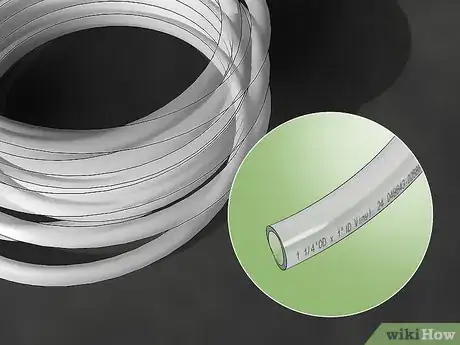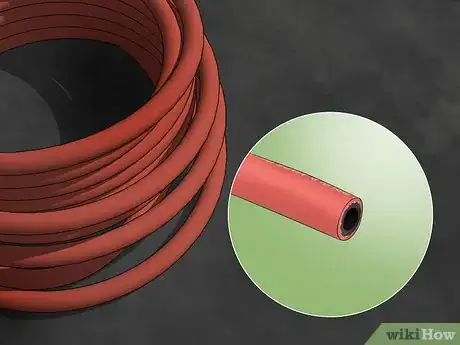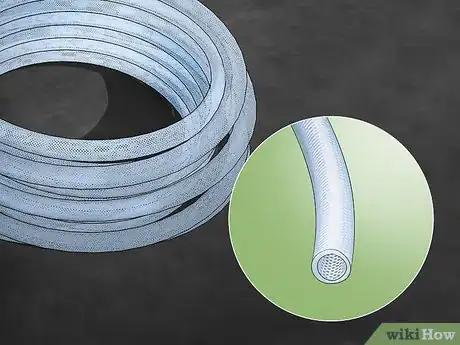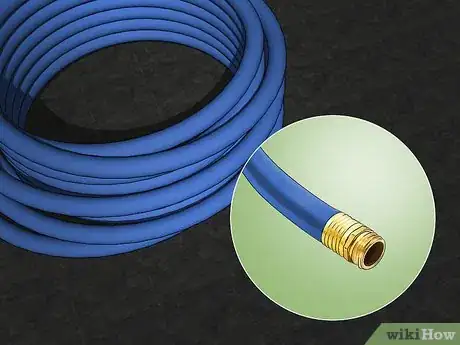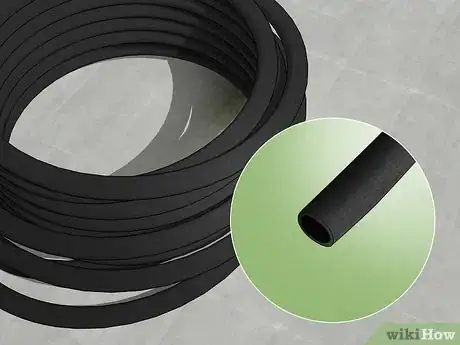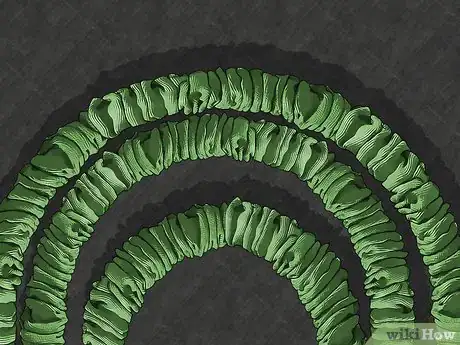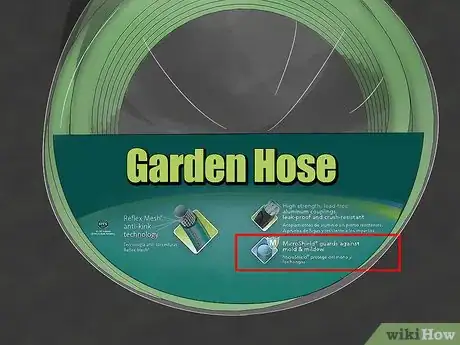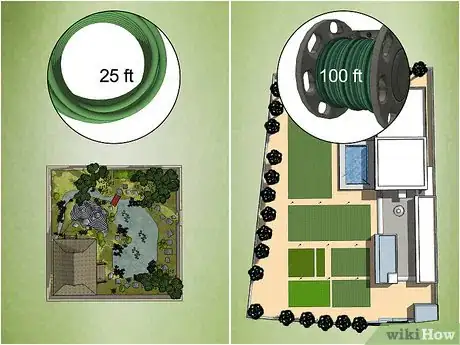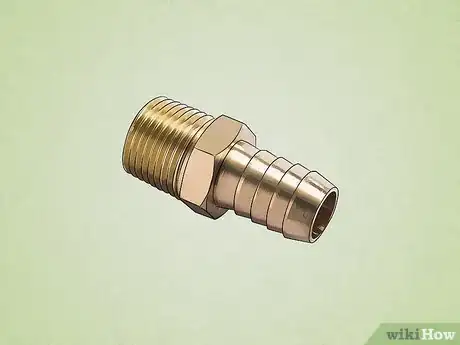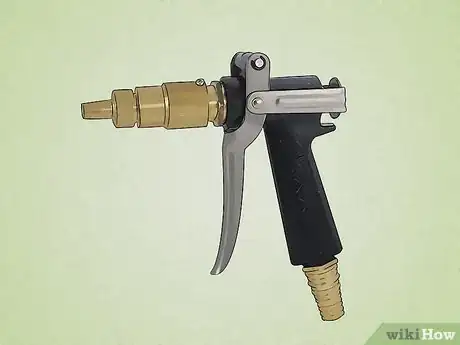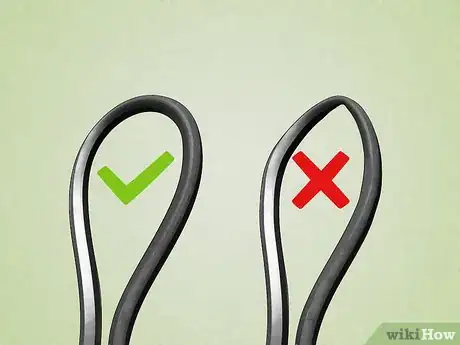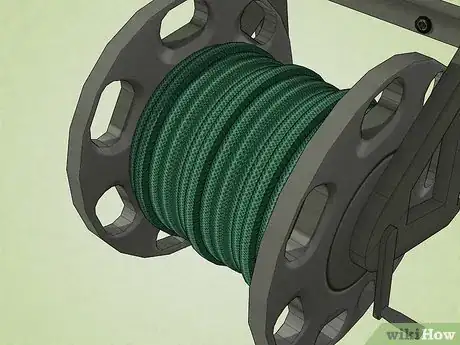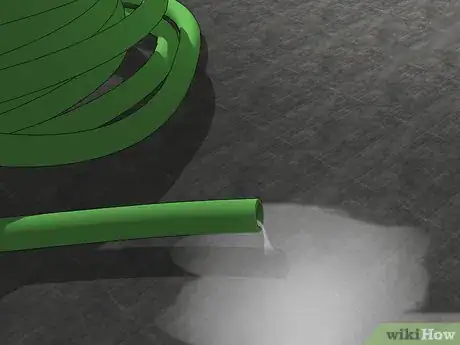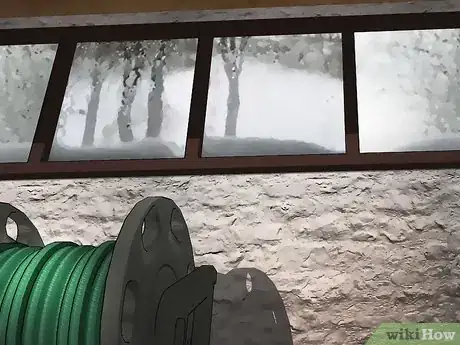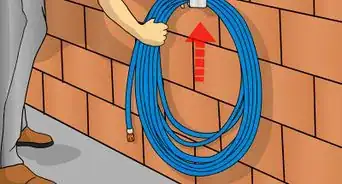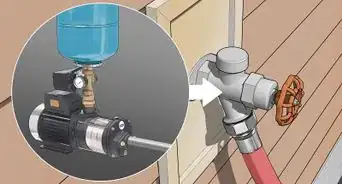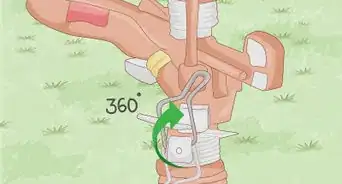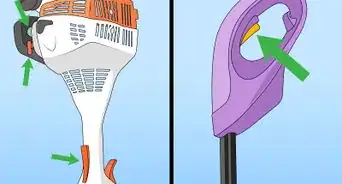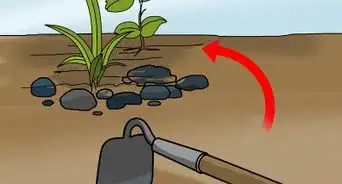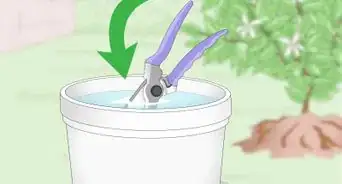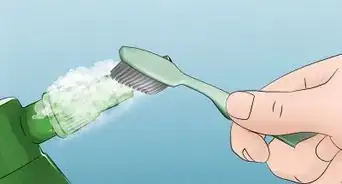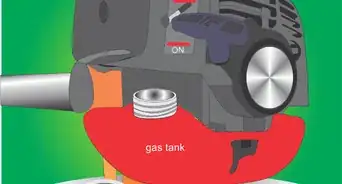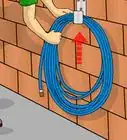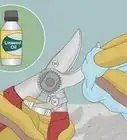This article was co-authored by Maggie Moran and by wikiHow staff writer, Sophia Latorre. Maggie Moran is a Professional Gardener in Pennsylvania.
This article has been viewed 119,675 times.
A garden hose is an essential piece of outdoor equipment, whether your lawn stretches across several acres or you have a simple patio garden to manage. There are many uses for a garden hose, including watering grass and plants, rinsing off backyard toys, and washing your car. Most hardware and home improvement stores have entire aisles devoted to garden hoses, so there are many options. Take a little time to consider all the options so that you purchase a garden hose that will fit your watering needs.
Steps
Matching Hose Types to Your Needs
-
1Choose a vinyl hose for easy handling. If you live in a mild climate and plan to use the hose to water your lawn or garden, vinyl is a suitable option. Vinyl hoses are light and easy to handle. They often cost less than rubber or reinforced hoses and are a good choice for basic watering needs.[1]
-
2Pick a rubber hose for more durability. Rubber hoses are heavier and harder to handle than vinyl hoses, and they also cost more money. However, they are better suited for extreme weather conditions and will last longer than a basic vinyl hose.[2]Advertisement
-
3Opt for a reinforced hose for commercial purposes. If you plan to use the hose commercially, or if your yard has a lot of equipment, furniture, or sharp objects, choose a reinforced hose. One that is made up of several layers with a mesh covering on the outside can help protect against snags and punctures.[3]
-
4Look for an industrial hose if you’ll be using hot water. Industrial hoses are constructed of rubber and include an abrasion-resistant covering. They offer a high burst strength and can be used with extremely hot water.[4]
-
5Choose a sprinkler or soaker hose for regular lawn watering. These hoses will “leak” through evenly spaced holes to provide water to the surrounding garden or lawn. Sprinkler hoses lay on the ground with the perforated side facing up and shoot water into the air. Soaker hoses lay on the ground with the perforated side facing sideways or down and allow water to trickle into the soil.[5]
-
6Pick an expandable hose for light watering needs. Expandable (or pocket) hoses stretch out when water is run through them, then shrink to a small size when not in use. They are great for light watering and fit well in small spaces. Be aware, however, that they need to be fully drained after every use.
- They may also be more susceptible to punctures and tears.
-
7Select a hose with antimicrobial protection. Many garden hoses provide the right environment for mold, yeast, bacteria, and fungus to grow. If you plan to fill a swimming pool, let your kids run through the sprinkler, or drink from the hose, it’s important to select a hose with antimicrobial protection.
Considering Length, Diameter, and Overall Quality
-
1Choose the length based on the size of your property. Garden hoses range from 10 feet (3.0 m) to over 100 feet (30 m) in length. If you have a small lot and simply need to water your grass or flowers, a short hose, such as one that’s 25 feet (7.6 m), should work well. If you have several acres of property, you’ll need to opt for a longer hose, like 100 feet (30 m).[6]
- You can also connect two garden hoses together to reach a farther distance.
-
2Let your pressure needs determine the diameter. A hose with a 1⁄2 inch (1.3 cm) diameter will deliver about 9 gallons (34 L) of water per minute. This is sufficient for basic lawn and garden watering. A hose with a 5⁄8 inch (1.6 cm) diameter will deliver about 17 gallons (64 L) of water per minute. A hose diameter of 3⁄4 inch (1.9 cm) will deliver about 23 gallons (87 L) of water per minute.
- The wider the diameter, the less pressure is lost over distance.
-
3Look for cast brass fittings. Solid, crush-proof fittings are a must for your garden hose. Choose cast brass, rather than stamped brass, to ensure that you won’t need to replace the hose due to damaged fittings. Cast brass fittings also indicate that the hose is high quality.[7]
-
4Pick a brass nozzle to reduce leaks. Attaching a nozzle to the end of the hose changes the way that water is delivered. The nozzle can be twisted to produce a fine spray or a strong stream of water. For the most flexibility in your watering, choose an adjustable nozzle. A brass nozzle will fit better and last longer than a plastic one.[8]
-
5Bend the hose to see if it kinks before purchasing it. While you’re in the store, unroll about 2 feet (0.61 m) of hose and bend it in half. Though many hoses are advertised as kink-free, most of them are not. Test several hoses to find one that simply bends, rather than kinks.[9]
Caring for your Hose
-
1Store your hose on a reel to reduce damage. Coil your hose on a reel to prevent bends or kinks from forming. Reels can stand alone on a cart so that you can tote it around your property, or they can be mounted to the wall. Reels are available at the same places you will find garden hoses.
-
2Drain the hose before the first frost. If you live in an area where temperatures dip below freezing, it’s important to drain all the water from your hose before the cold weather hits. Allow gravity to empty the hose by placing one end on an elevated surface, like a picnic table, and the other end on the ground.[10]
-
3Bring your hose indoors during the winter. Cold temperatures can cause the hose material to shrink, which may produce cracks. To prevent this from happening, store your hose indoors during the winter rather than leaving it outside. A garage or basement is a good place to keep the hose until warm weather returns.[11]
Expert Q&A
Did you know you can get expert answers for this article?
Unlock expert answers by supporting wikiHow
-
QuestionHow long do garden hoses last?
 Maggie MoranMaggie Moran is a Professional Gardener in Pennsylvania.
Maggie MoranMaggie Moran is a Professional Gardener in Pennsylvania.
Home & Garden Specialist
-
QuestionWhat is the pressure of a garden hose?
 Maggie MoranMaggie Moran is a Professional Gardener in Pennsylvania.
Maggie MoranMaggie Moran is a Professional Gardener in Pennsylvania.
Home & Garden Specialist
-
QuestionWhat is a standard size garden hose?
 Maggie MoranMaggie Moran is a Professional Gardener in Pennsylvania.
Maggie MoranMaggie Moran is a Professional Gardener in Pennsylvania.
Home & Garden Specialist
References
- ↑ http://www.popularmechanics.com/home/lawn-garden/how-to/a139/1273576/
- ↑ http://www.popularmechanics.com/home/lawn-garden/how-to/a139/1273576/
- ↑ http://www.popularmechanics.com/home/lawn-garden/how-to/a139/1273576/
- ↑ http://www.popularmechanics.com/home/lawn-garden/how-to/a139/1273576/
- ↑ http://www.popularmechanics.com/home/lawn-garden/how-to/a139/1273576/
- ↑ http://gilmour.com/how-to-choose-garden-hose
- ↑ https://www.familyhandyman.com/landscaping/finding-the-best-garden-hose/view-all/
- ↑ https://www.familyhandyman.com/landscaping/finding-the-best-garden-hose/view-all/
- ↑ https://www.familyhandyman.com/landscaping/finding-the-best-garden-hose/view-all/
About This Article
Choosing the right garden hose will depend on what you need it for and how much you want to spend. Vinyl hoses are great if you live in a mild climate and want something that’s lightweight and easy to handle. If you live in a harsher climate and want a more durable hose, a rubber hose or reinforced hose may be a better option. Just keep in mind that these usually cost more. Sprinkler or soaker hoses are great for lawn watering since they have evenly spaced holes where water shoots out. If you let your kids play in the sprinkler or if you have a pet that will drink from the hose, consider getting a hose with antimicrobial protection, which will prevent the growth of mold, yeast, and bacteria. To learn how to determine which hose diameter is right for you, read more from our Gardening co-author!
